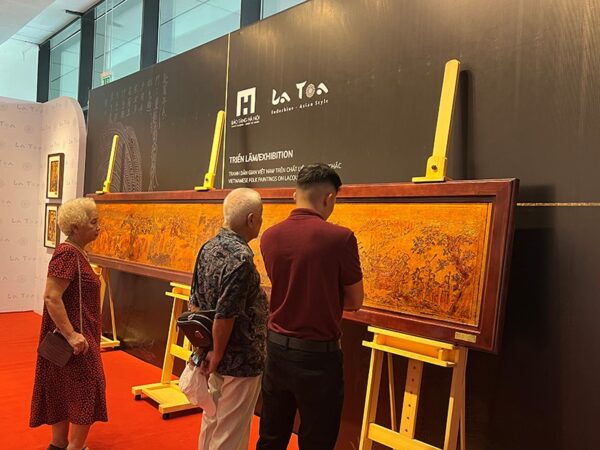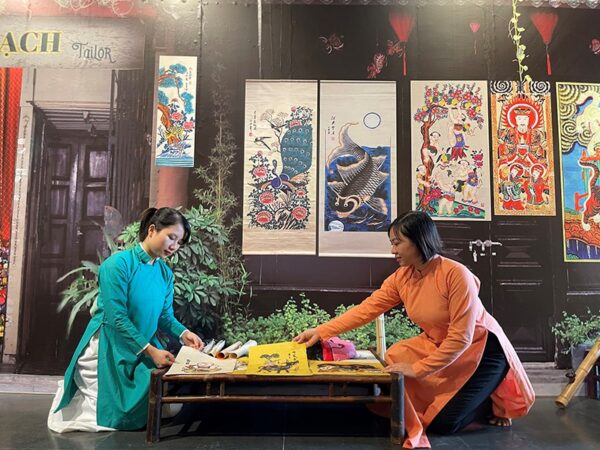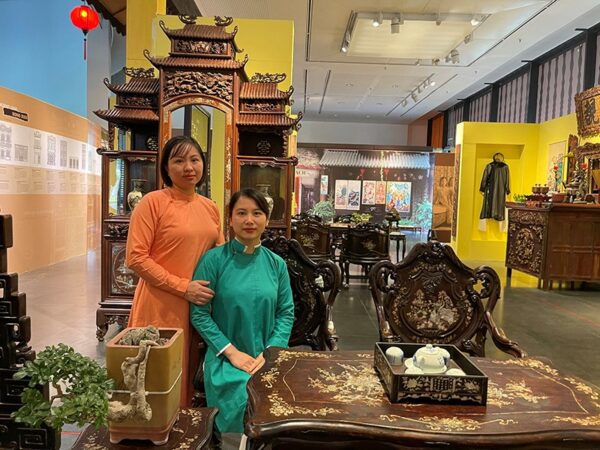On the afternoon of November 7, Hanoi Museum collaborated with Latoa Indochine to open an exhibition of folk paintings with the theme “The Journey”. This is one of the activities towards the 68th anniversary of Capital Liberation Day (October 10, 1954 – October 10, 2022).
Attendees included Mr. Nguyen Thanh Binh – Head of the Department of Culture and Social Affairs of the People’s Council of Hanoi; Mr. Do Dinh Hong – Director of Hanoi Department of Culture and Sports; Ms. Pham Thi My Hoa – Deputy Director of Hanoi Department of Culture and Sports; Assoc. Prof. Dr. Do Van Tru – Chairman of Vietnam Heritage Association; together with leaders of departments, divisions and units under Hanoi Department of Culture and Sports, scientists and researchers.


Delegates cut the opening ribbon and visited the Exhibition.
The exhibition showcases nearly 100 works of art made by the group of artists at Latoa Indochine. All works are on familiar folk painting themes such as Hang Trong – Dong Ho – Kim Hoang paintings but are completely renewed on engraved lacquer material (a combination of lacquer and engraving).
There are 3 main groups of paintings displayed at the exhibition: Folk paintings, paintings of the Great Luminary Nguyen Trai (1380-1442), Buddhist paintings. In which, folk painting themes are applied and composed with rich colors. Than Ke painting of Kim Hoang village is one of the famous paintings that have been restored, with the meaning of bringing good luck.
Ngu Ho painting, belonging to the Hang Trong line of paintings, expresses the desire to send people in the five directions, and subdue evil forces. The painting takes the image of 5 male tigers to represent Five Elements, ie the mutual and opposite universe, creating the survival space of all things, including humans.
The exhibition introduces paintings inspired by Buddhism such as: An adaptation of the paintings “Truc Lam Dai Si Xuat Son Do”, “Huong Van Dai Dau Da”, etc.


Some pictures of the Exhibition.
With a new expression, the exhibition of folk paintings with the theme “The Journey” offers art lovers an interesting and creative perspective on the nation’s traditional paintings, and at the same time, contributes to develop an ancient culture to a new height, blending the idyllic folk and the modern and progressive flow.
During the exhibition, the Hanoi Museum and Latoa Indochine also collaborated for the adaptation of Nguyen Trai’s portrait painting into engraved lacquer material in size 106cm x 106cm and put it on display. The original painting was painted with gouache on fabric in 1917, signed with the author’s name: P.D.TUE, January 1, 1917, with dimensions of 220cm x 200cm. The portrait of Nguyen Trai is drawn with stylized strokes, skillfully dithered with many curves calculated according to certain formulas.
At the exhibition, Mr. Pham Ngoc Long, President of Latoa Indochine said: “This is the “journey” that Latoa Indochine has cherished for a long time, a journey built by people who love and cherish national cultural beauty. At the same time, the desire to preserve the cultural and artistic values, the national values, the feng shui values are hidden in each old folk painting work and raised to a new height on the traditional engraved lacquer material. Because, folk paintings are not ordinary things but one of the cultural heritages, preserving and reflecting the nuances, customs and practices of each region on the S-shaped strip of land.”


Some pictures of the Exhibition.
Appreciating the project, researcher and artist Phan Ngoc Khue said that lines of folk paintings on lacquer material not only help introduce to the domestic and foreign public about folk paintings, but also introduce traditional lacquer painting techniques. “The lacquer paintings inlaid with gold and silver create contrasting colors and catch the light, providing folk paintings with a new image of luxury and value. This is really a project to preserve and promote meaningful folk paintings, which should be replicated and developed,” said researcher Phan Ngoc Khue.
Mr. Nguyen Tien Da, Director of the Hanoi Museum also shared that the exhibition is a very meaningful event, making an important contribution to the Project of Conservation of Vietnamese Folk Paintings. Through the exhibition, the Organizing Committee wishes to bring viewers “to the origin of tradition” back to the days of old folk paintings to see, feel and appreciate a glorious beauty of the time. Then, we will together preserve and spread those values on the current path of development.”
The exhibition runs until December 31 at Hanoi Museum, Pham Hung Street, Me Tri Ward, Nam Tu Liem District, Hanoi.
Previously, on August 6, at the 1st floor, Hanoi Museum also held the exhibition “Nếp xưa” (Traditional customs) introducing nearly 200 documents of artifacts according to 4 main contents: Living room; Worship room; Villa; and five-flap dress. The exhibition recalls the lives of urban affluent families with a variety of artifacts and documents collected in the country and abroad, helping the public to better understand the life of this period. At the same time, it is to convey good traditional cultural values to the next generation, creating a connection between traditional culture and current culture.


Some pictures of Exhibition “Nếp xưa”.
Thuy Nga

